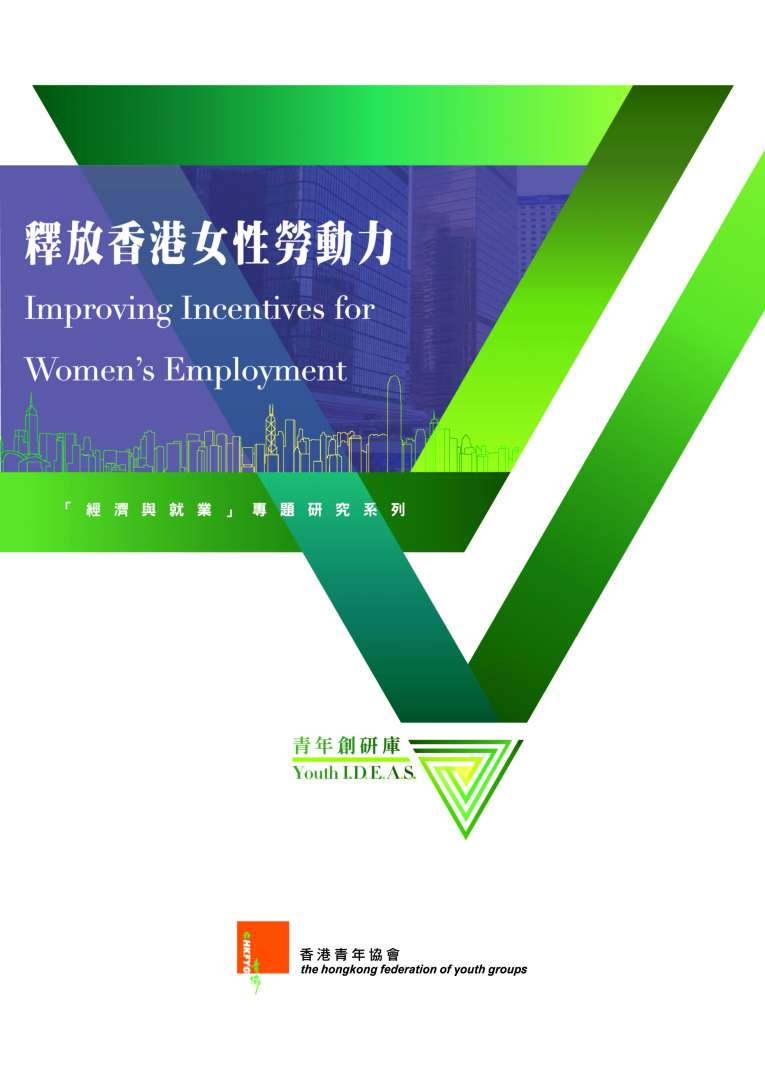Improving Incentives for Women’s Employment
Youth I.D.E.A.S. 35
Employment and Economic Development
Improving Incentives for Women’s Employment
30 October, 2018
 According to the Census and Statistics Department,[1] the overall labour force participation rate in Hong Kong will decrease gradually from 59.2% in 2016 to 49.6% in 2066. The figure reflects the fact that the labour force is gradually shrinking due to an aging population, a trend that might hinder Hong Kong’s overall economic development. Consequently, in its latest report, the Employment and Economic Development Group of the Youth I.D.E.A.S. has discussed the issue of encouraging young-olds’ employment as a means of alleviating the problem of a shrinking labour force.
According to the Census and Statistics Department,[1] the overall labour force participation rate in Hong Kong will decrease gradually from 59.2% in 2016 to 49.6% in 2066. The figure reflects the fact that the labour force is gradually shrinking due to an aging population, a trend that might hinder Hong Kong’s overall economic development. Consequently, in its latest report, the Employment and Economic Development Group of the Youth I.D.E.A.S. has discussed the issue of encouraging young-olds’ employment as a means of alleviating the problem of a shrinking labour force.
Enabling more women to go to work is another solution for reversing Hong Kong’s shrinking labour force. Due to increasing educational opportunities, the labour force participation rate of women has been rising. However, women’s employment is still far behind that of men’s. In 2017, the overall labour force participation rate of women aged 15 or above was 50.9% while that of men was 68.3% (excluding foreign domestic helpers).[2]
It is generally believed that the lower employment rate of women is due to their responsibility of taking care of family members, especially young children. Figures from 2016 showed that the labour force participation rate of never married women was 65.1% while that of ever married women was as low as 44.1%, only a slight increase from 42.8% ten years ago.[3] The labour force participation rate of ever married women was 21 percentage points lower than that of never married women (excluding foreign domestic helpers),[4] which represented 486,000 individuals. Assuming that one-fifth of them are employed, the labour force can then be increased by 100,000, which is helpful to supplement the labour force shortage.
There are around 55,000 to 60,000 newborn babies every year in Hong Kong.[5] However, the number of subvented childcare services places for children under 3 was only 772 in 2018[6] throughout the territory. According to the planning standard, whole day kindergarten and nursery accommodation for children under 6 is only 25% of total accommodation.[7] In addition, the number of After School Care Programme places for children aged between 6 and 12 is only 5,658.[8] All these figures reflect a great shortage of childcare services in Hong Kong, which is a main barrier for mothers who wish to be employed.
Research[9] has shown that countries such as Finland and Norway, which provide adequate childcare services and implement family-friendly employment practices, have a higher women’s employment rate. These countries are more likely to encourage women to re-enter the workplace after giving birth. However, it is still unpopular in Hong Kong to implement family-friendly employment practices. Such a situation may affect the supply of women’s labour significantly.
This study is a discussion of how to unleash women’s labour force so that women within the main employment age (25-54) who are willing to work are provided with more opportunities. The problem is examined by looking at current childcare services and family-friendly employment practices. The aim of this study is to increase overall labour force supply, to improve the economic ability of women, and to provide diversified opportunities for personal development. An attempt is made to give concrete recommendations by studying foreign policies and experiences, understanding the employment barriers faced by women with children aged 12 or younger, and the opinions of Hong Kong residents on childcare services and family-friendly employment practices.
Data in this study was collected using three methods during the period from August to September 2018: an on-site survey of 520 Hong Kong residents aged 18 or above, case interviews with 20 women aged 25-54 with children aged 12 or younger, and interviews with 6 experts and scholars.
Discussion
- The potential of women’s labour force in Hong Kong is yet to be fully utilized. Due to an aging population, the labour force is gradually shrinking and this might hinder the overall economic development of Hong Kong. The potential of women’s labour force should not be ignored when working towards alleviating the problem. Figures show that there was a difference of 17 percentage points between the labour force participation rates of men and women. Besides, the figure of ever married women was 21 percentage points lower than that of never married women.
- Some women are still interested in employment after giving birth. Survey respondents support women’s employment in general. They agree that women’s employment is beneficial to the economic development of Hong Kong. However, their attitudes become contradictory when considering the need for childcare. The in-depth interviews show that the women interviewees are quite willing to be employed. Even though some women choose to take care of their children on a full-time basis, they still hope to work in their spare time or to rejoin the labour force after their children have grown up.
- There are dilemmas and barriers to maintaining employment and taking care of the family at the same time. Many women experience tension as a result of concurrent employment and childcare. This is one of the main barriers for them to join the work force.
3.1 Support and measures for childcare are in severe shortage. The quantity and service hours of childcare services can hardly meet the needs of employed women.
3.2 Family-friendly employment practices are unpopular in the Hong Kong workplace. Moreover, since jobs are not flexible enough, women who need to take care of their children are unable to enter the labour market.
- Full support and assistance are important incentives to encourage women’s employment. If women fail to get childcare services or if their employers do not implement family-friendly employment practices, they must rely on adequate economic and interpersonal resources, otherwise it is difficult to encourage them to look for employment.
- Hong Kong residents generally supported women’s employment, but employers have reservations. More than 80% of respondents supported improvements in women’s employment. Nevertheless, they only rate 4.11 points on HKSARG’s work in this area. Employers’ attitudes are also significant..
- Current family-friendly policies are inadequate. Hong Kong is very much lagging behind in the adoption of family-friendly employment measures. The government should make more effort in this respect.
Recommendation
- Introduce an After School Care Programme for all primary schools based on a tripartite cooperation model whereby the schools provide the venue, NGOs offer the services and the government offers a subsidy.
- Offer a Family-Friendly Practices Grant that provides incentives for enterprises that implement flexible work arrangements.
- The government should take the lead to split selected positions so as to provide more part-time posts. This arrangement can promote the culture of flexible work.
- Public bodies such as universities and non-governmental organizations could provide home office arrangements for selected jobs and then use the experience gained to motivate the commercial sector.
- Gradually increase the ratio of half day to whole day kindergarten and nursery accommodation from 3:1 to 1:1.
[1] Census and Statistics Department. (2017). Hong Kong labour force projections for 2017 to 2066. Hong Kong: Census and Statistics Department.
[2] Census and Statistics Department. (2018). Women and men in Hong Kong – key statistics 2018 edition. Hong Kong: Census and Statistics Department.
[3] Census and Statistics Department. “2016 population by-census”. Retrieved from https://www.bycensus2016.gov.hk/tc/index.html
[4] Census and Statistics Department. (2018). Women and men in Hong Kong – key statistics 2018 edition. Hong Kong: Census and Statistics Department.
[5] Census and Statistics Department. (2018). Women and men in Hong Kong – key statistics 2018 edition. Hong Kong: Census and Statistics Department.
[6] Source: Social Welfare Department.
[7] Source: School Education Statistics Section, Education Bureau.
[8] Source: Labour and Welfare Bureau. (2018). “LCQ12: Child care services”. Retrieved from https://www.lwb.gov.hk/chi/legco/28032018_3.htm
[9] Fang, G. (2015). “How to encourage women into the workforce”. World Economic Forum. Retrieved from https://www.weforum.org/agenda/2015/03/how-to-encourage-women-into-the-workforce/




